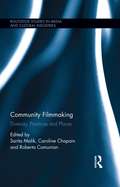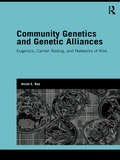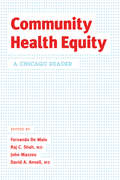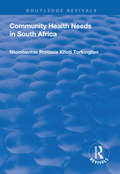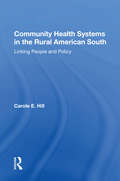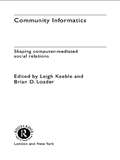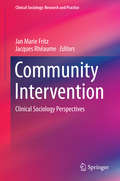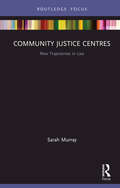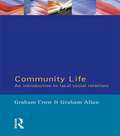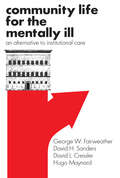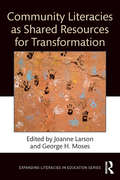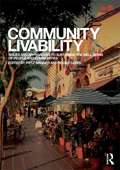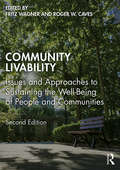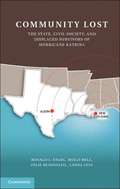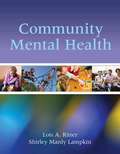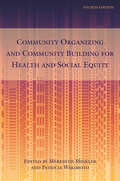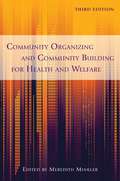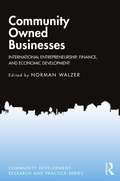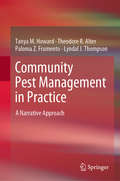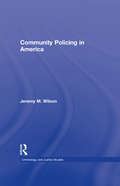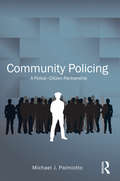- Table View
- List View
Community Filmmaking: Diversity, Practices and Places (Routledge Studies in Media and Cultural Industries)
by Sarita Malik Caroline Chapain Roberta ComunianThis book examines the role of community filmmaking in society and its connection with issues of cultural diversity, innovation, policy and practice in various places. Deploying a range of examples from Europe, North America, Australia and Hong Kong, the chapters show that film emerging from outside the mainstream film industries and within community contexts can lead to innovation in terms of both content and processes and a better representation of the cultural diversity of a range of communities and places. The book aims to situate the community filmmaker as the central node in the complex network of relationships between diverse communities, funding bodies, policy and the film industries.
Community Genetics and Genetic Alliances: Eugenics, Carrier Testing, and Networks of Risk (Genetics and Society)
by Aviad E. RazCarrier testing of adults provides information about the risk of passing a genetic mutation to your children, leading to reproductive (and some say, eugenic) decisions. Excessive carrier screening may have adverse effects, but it can also prevent suffering and open up new reproductive options. Raz's study focuses on the interplay of community genetics (the medical organisation of carrier screening) and genetic alliances (networks of individuals at risk), exploring how 'genetic communities' are emerging both within existing ethnic groups and around patients' organizations. While the interplay between carrier testing, reproduction and eugenics has sparked many discussions, this study provides a novel and much-needed perspective on its actual implementation and interpretation by community members. Conflating a cross-cultural spectrum of genetic communities, the benefits and perils of supporting (or restricting) carrier screening are located within broader social issues such as religion, ethnicity, multi-culturalism, abortion, stigmatization, suffering and care-giving. While carrier screening emerges as ultimately a morally justified pronatalist endeavour for the reduction of suffering, thus being different in principle from the 'old' eugenics, it can also carry unintended adverse consequences if left unattended to consumers, communities, or health professionals.
Community Health Equity: A Chicago Reader
by David A. Ansell Fernando De Maio Raj C. Shah John MazzeoPerhaps more than any other American city, Chicago has been a center for the study of both urban history and economic inequity. Community Health Equity assembles a century of research to show the range of effects that Chicago’s structural socioeconomic inequalities have had on patients and medical facilities alike. The work collected here makes clear that when a city is sharply divided by power, wealth, and race, the citizens who most need high-quality health care and social services have the greatest difficulty accessing them. Achieving good health is not simply a matter of making the right choices as an individual, the research demonstrates: it’s the product of large-scale political and economic forces. Understanding these forces, and what we can do to correct them, should be critical not only to doctors but to sociologists and students of the urban environment—and no city offers more inspiring examples for action to overcome social injustice in health than Chicago.
Community Health Needs in South Africa
by Ntombenhle Protasia TorkingtonThis title was first published in 2000: Although the apartheid regime has now been abolished there is still a great deal of work to be done in order to eliminate the disadvantages it created for the health of black people at both micro and macro levels. This book presents the findings of a study commissioned to assess and respond to the health needs of black people in South Africa. The hope expressed by those who participated is that the study is considered within the wider context of understanding the apartheid system and the scars it left behind. Community Health Needs in South Africa represents an excellent example of how action research can be used as a tool to make a difference in people’s lives.
Community Health Systems In The Rural American South: Linking People And Policy
by Carole E HillA cultural perspective of health care systems can provide health care providers and policymakers with a broader understanding of the issues they face when planning and implementing new health programs in communities. Healthcare tales place in a community setting while health care policy is developed at an entirely different level in the larger socioeconomic system. In this study the author attempts to link the community level systems of health with those of the policy level system and allow for a comparison of the convergence and divergence of people's health beliefs and behavior with those of policymakers and of medical anthropology in Coberly.
Community Identity and Political Behavior
by Mary R. AndersonSocial scientists are motivated to understand how various facets of society influence all sorts of behavior. Individual's perceptions about their significance in a given community can have meaningful effects on the way in which we look to communities to develop and foster democratic values and promote civic engagement. The focus of this book is on how community comes to influence political behavior; it takes an interdisciplinary approach blending the fields of community psychology, sociology, and political science. We know from previous research that the context in which an individual interacts influences his/her political behaviors and attitudes. With this in mind, the present research addresses two major questions, 1) how does sense of community influence political behavior and attitudes? and 2) what impact - if any - does involvement in multiple contexts have on political behavior and attitudes?
Community Informatics: Shaping Computer-Mediated Social Networks
by Brian D. Loader Leigh KeebleCommunity groups, social support networks, voluntary agencies and government organisations are all actively exploring the potential of the new information and communication technologies to bring about democratic development and renewal. A rich variety of social experiments in what has become known as Community Informatics is now beginning to provide useful research findings and exciting examples of innovative applications.This book sets down some of the defining features of a Community Informatics approach and some of the common themes which are emerging. In particular it considers the following issues:* sustainability* employment* community management* public service provision* partnerships of stakeholders* local learning* social support and networks.This edited collection brings together leading exponents of Community Informatics from around the world and critically evaluates their experiences.
Community Intervention: Clinical Sociology Perspectives (Clinical Sociology: Research and Practice)
by Jan Marie Fritz Jacques RhéaumeCommunity Intervention: Clinical Sociology Perspectives showcases important efforts to improve the quality of life in communities around the world. The book, a project of the clinical sociology division of the International Sociological Association, describes the interdisciplinary field of clinical sociology in relation to community improvement. The first part of the book covers important concepts and tools for community intervention and identifies a variety of approaches to community research with an emphasis on research that centrally involves community members. The chapters in the second part of the volume focus on projects in a broad range of countries, covering topics such as involving residents in urban renewal projects, developing healthy communities, encouraging socioeconomic development, improving the life of immigrants, helping communities deal with climate change, establishing human rights cities, encouraging empowerment and creating an inclusive community. A unique feature of the book is the inclusion of profiles about some of the outstanding work in community intervention over the last 100 years. These profiles are of Nobel Peace Prize winner Jane Addams; community activist Saul Alinsky; human rights and environmental activist Wangari Maathai and participatory action research pioneer Orlando Fals Borda. Written by scholar-practitioners as well as analysts, the book provides essential commentary regarding community intervention efforts.
Community Justice Centres: New Trajectories in Law (New Trajectories in Law)
by Sarah MurrayThis book examines the phenomenon of Community Justice Centres and their potential to transform the justice landscape by tackling the underlying causes of crime. Marred by recidivism, addiction, family violence, overflowing courtrooms, crippling prison spending and extreme rates of incarceration, the criminal justice system is in crisis. Community Justice Centres seek to combat this by tackling the underlying causes of crime in a particular neighbourhood and working with local people to redesign the experience of justice and enhance the notion of community. A Community Justice Centre houses a court which works with an interdisciplinary team to address the causes of criminality such as drug addiction, cognitive impairment, mental illness, poverty, abuse and intergenerational trauma. The community thus becomes a key agent of change, partnering with the Centre to tackle local issues and improve safety and community cohesion. This book, based on research into this innovative justice model, examines case studies from around the world, the challenges presented by the model and the potential for bringing its learnings into the mainstream. This book will appeal to academics in law and criminology as well as psychology; it will also be of considerable interest to people working in the criminal justice system, including the police, government policy advisers, psychologists and social workers.
Community Life
by Graham Crow Graham AllanFirst published in 1994. Routledge is an imprint of Taylor & Francis, an informa company.
Community Life for the Mentally Ill: An Alternative to Institutional Care
by George W. Fairweather David H. Sanders David L. Cressler Hugo Maynard"Community Life for the Mentally Ill" presents a social innovative experiment aimed at providing new and more participating social positions in American society for mental patients. It presents the events that occurred when a courageous group of former chronic mental patients abruptly left a hospital and established their own autonomous sub-society in a large, metropolitan area.In order to complete this experiment, the patients created a small society in the community where discharged patients could live and work. Others evaluated the effects of the newly created society upon the behavior and perceptions of its members, which is also presented here. Both the descriptive and comparative aspects of this study are presented as they occurred in real life. The book is concerned with the medical, economic, sociological, and psychological facets of these former patients' daily lives. The effects of this small society upon the neighborhood and city in which it was located, as well as its effects upon professional persons, are richly explored.Clearly defining a radical departure from standard methods for treating the mentally ill, the authors conclude that such an autonomous society can thrive in the appropriate setting; the ex-patient's chances of employment are increased and the chance of recidivism are reduced; the member's self-esteem is enhanced; treatment costs are greatly reduced; the community adjustment of all members is increased, especially among those who have been hospitalized for a long period. With new guidelines for identifying danger zones in urban settings, this becomes a critical work.
Community Literacies as Shared Resources for Transformation (Expanding Literacies in Education)
by Joanne Larson George H. MosesThrough multiple narratives reflecting the complexity of participatory action research partnerships for social justice, this book sheds light on the dialogic spaces that intentionally support community literacies and rhetorical practices for inquiry and change. Applying literacy as social practice, Larson and Moses tell a story of a unique collaboration between community members and university faculty and students, who together transformed an urban corner store into a cornerstone of the community. Building on the emerging field of community literacies, the book captures the group’s active work on the ground and, on another level, how transformation occurred in the dialogic spaces of the research team as it learned to embrace distributed expertise and multiple identities.
Community Livability: Issues and Approaches to Sustaining the Well-Being of People and Communities
by Roger Caves Fritz WagnerWhat is a livable community? How do you design and develop one? What does government at all levels need to do to support and nuture the cause of livable communities? Using a blend of theory and practice, experts in the field look at evidence from international, state and local perspectives to explore what is meant by the term "livable communities". Chapters examine the various influencing factors such as the effect and importance of transportation options/alternatives to the elderly, the significance of walkability as a factor in developing a livable and healthy community, the importance of good open space providing for human activity and health, restorative benefits, the importance of coordinated land use and transportation planning, and the relationship between livability and quality of life. While much of the discussion of this topic is usually theoretical and abstract, Wagner and Caves use case studies from North America, Brazil and the United Kingdom to provide substantive examples of initiatives implemented across the world. This book fills an important gap in the literature on livable communities and at the same time assists policy officials, professionals and academics in their quest to develop livable communities.
Community Livability: Issues and Approaches to Sustaining the Well-Being of People and Communities
by Fritz Wagner Roger W. CavesWhat is a livable community? How do you design and develop one? What does government at all levels need to do to support and nurture the cause of livable communities? Using a blend of theory and practice, the second edition of Community Livability addresses evidence from international, state and local perspectives to explore what is meant by the term "livable communities." The second edition contains new chapters from leading academics and practitioners that examine the various factors that constitute a livable community (e.g., the influence and importance of transportation options/alternatives to the elderly, the importance of walkability as a factor in developing a livable and healthy community, the importance of good open space providing for human activity and health, restorative benefits, etc., the importance of coordinated land use and transportation planning), and the relationship between livability and quality of life. A number of chapters focus on livable communities with case studies from an international perspective in USA, Canada, Australia, Peru, Sweden, South Korea, Japan, and Austria.
Community Lost: The State, Civil Society, and Displaced Survivors of Hurricane Katrina
by Ronald J. Angel Holly Bell Julie Beausoleil Laura LeinNeither government programs nor massive charitable efforts responded adequately to the human crisis that was Hurricane Katrina. In this study, the authors use extensive interviews with Katrina evacuees and reports from service providers to identify what helped or hindered the reestablishment of the lives of hurricane survivors who relocated to Austin, Texas. Drawing on social capital and social network theory, the authors assess the complementary, and often conflicting, roles of FEMA, other governmental agencies, and a range of non-governmental organizations in addressing survivors' short- and longer-term needs. While these organizations came together to assist with immediate emergency needs, even collectively they could not deal with survivors' long-term needs for employment, affordable housing, and personal records necessary to rebuild lives. Community Lost provides empirical evidence that civil society organizations cannot substitute for an efficient and benevolent state, which is necessary for society to function.
Community Mental Health
by Lois A. Ritter Shirley Manly LampkinCommunity Mental Health is unique in that it focuses specifically on mental health at the community level. The authors carefully outline the essential skills that health professionals need in order to identify mental health concerns and develop effective programs for communities encountering symptoms of mental disorders or illness. The text includes up-to-date information about mental health issues across the lifespan, the mental health care system, prominent mental health concerns faced by many communities, as well as information about interventions and model programs. The breadth of topics related to community mental health addressed include: indicators of illness and problems, methods of prevention and promotion, evaluation, and research. Instructor Resources, including PowerPoint Presentations, a TestBank, and an Instructor Manual are available as free downloads.
Community Nutrition Resilience in Greater Miami: Feeding Communities in the Face of Climate Change (Palgrave Studies in Climate Resilient Societies)
by Franziska Alesso-BendischThis book conceptualizes community nutrition resilience as a critical area that is currently lacking the attention it requires from both the public and private sectors. The book spotlights Greater Miami’s resilience efforts, both responding to slowly developing challenges such as immigration, environmental deterioration, and the wealth distribution gap, as well as sudden disasters such as hurricanes or flooding driven by climate change. Drawing on existing literature as well as interviews with professionals working in the field, the author makes recommendations on how to incorporate food systems into urban resilience planning, how to prioritize resilience on urban food agendas, and how to strengthen food system resilience through public, private, and third sector level engagement. She also highlights how the availability of and access to nutritious food impact the health, performance, and well-being of communities in the region, thus making a strong case for the prioritization of this growing issue.
Community Organizing
by David S. WallsThis incisive book provides a critical history and analysis of community organizing, the tradition of bringing groups together to build power and forge grassroots leadership for social, economic, racial, and environmental justice. Begun by Saul Alinsky in the 1930s, there are today nearly 200 institution-based groups active in 40 U. S. states, and the movement is spreading internationally. David Walls charts how community organizing has transcended the neighborhood to seek power and influence at the metropolitan, state, and national levels, together with such allies as unions and human rights advocates. Some organizing networks have embraced these goals while others have been more cautious, and the growing profile of community organizing has even charged political debate. Importantly, Walls engages social movements literature to bring insights to our understanding of community organizing networks, their methods, allies and opponents, and to show how community organizing offers concepts and tools that are indispensable to a democratic strategy of social change. Community Organizing will be essential reading for advanced undergraduates and graduate students of sociology, social movements and social work. It will also inform organizers and grassroots leaders, as well as the elected officials and others who contend with them.
Community Organizing (Social Movements)
by David S. WallsThis incisive book provides a critical history and analysis of community organizing, the tradition of bringing groups together to build power and forge grassroots leadership for social, economic, racial, and environmental justice. Begun by Saul Alinsky in the 1930s, there are today nearly 200 institution-based groups active in 40 U.S. states, and the movement is spreading internationally. David Walls charts how community organizing has transcended the neighborhood to seek power and influence at the metropolitan, state, and national levels, together with such allies as unions and human rights advocates. Some organizing networks have embraced these goals while others have been more cautious, and the growing profile of community organizing has even charged political debate. Importantly, Walls engages social movements literature to bring insights to our understanding of community organizing networks, their methods, allies and opponents, and to show how community organizing offers concepts and tools that are indispensable to a democratic strategy of social change. Community Organizing will be essential reading for advanced undergraduates and graduate students of sociology, social movements and social work. It will also inform organizers and grassroots leaders, as well as the elected officials and others who contend with them.
Community Organizing and Community Building for Health and Social Equity, 4th edition
by Barack Obama Stephen B. Thomas Rinku Sen John P. Kretzmann Rachel Morello-Frosch Meredith Minkler Nina Wallerstein Barbara A. Israel Eugenia Eng Edith A. Parker Tom Wolff Celina Su Manuel Pastor Jason Corburn Whitney Johnson Ronald Labonté Mark S. Homan Christine Mitchell Michelle C. Kegler Patricia Wakimoto Lionel J. Beaulieu Adam B. Becker Lynn Blanchard Anne Bluethenthal Frances Dunn Butterfross Lisa Cacari Stone Caricia Catalani Charlotte Yu-Ting Chang Roxana Chen Wayland X. Coleman Chris M. Coombe Lori Dorfman Nancy Epstein Jessica Estrada Jennifer Falbe Stephanie A. Farquhar Prisila Gonzalez Joseph Griffin Leslie Grover Lorraine Gutiérrez Trevor Hancock Susana Hennesey Laverty Reva Hines Lili Farhang Solange Gould Cheryl A. Hyde Anthony B. Iton Josh Kirschenbaum Blishda Lacet Pam Tau Lee Edith A. Lewis Jennifer Lifshay Laura Linnan Shaw San Liu Shaddai Martinez Cuestas Marty Martinson John L. McKnight Mary Anne Morgan Angela Ni Susan Racine Passmore Amber Akemi Piatt Cheri A. Pies Clara Pinsky R. David Rebanal Kathleen M. Roe Zachary Rowe Alicia L. Salvatore Shannon Sanchez-Youngman Amy J. Shulz Lee Staples Makani Themba Maria Elena Torre Evan Vandommelen-Gonzalez Dierde Visser Kirsten Wysen Marisa Ruiz Asari Nickie Bazell Derek M Griffith Heather CameThe fourth edition of Community Organizing and Community Building for Health and Social Equity provides both classic and recent contributions to the field, with a special accent on how these approaches can contribute to health and social equity. The 23 chapters offer conceptual frameworks, skill- building and case studies in areas like coalition building, organizing by and with women of color, community assessment, and the power of the arts, the Internet, social media, and policy and media advocacy in such work. The use of participatory evaluation and strategies and tips on fundraising for community organizing also are presented, as are the ethical challenges that can arise in this work, and helpful tools for anticipating and addressing them. Also included are study questions for use in the classroom. Many of the book’s contributors are leaders in their academic fields, from public health and social work, to community psychology and urban and regional planning, and to social and political science. One author was the 44th president of the United States, himself a former community organizer in Chicago, who reflects on his earlier vocation and its importance. Other contributors are inspiring community leaders whose work on-the-ground and in partnership with us “outsiders” highlights both the power of collaboration, and the cultural humility and other skills required to do it well. Throughout this book, and particularly in the case studies and examples shared, the role of context is critical, and never far from view. Included here most recently are the horrific and continuing toll of the COVID-19 pandemic, and a long overdue, yet still greatly circumscribed, “national reckoning with systemic racism,” in the aftermath of the brutal police killing of yet another unarmed Black person, and then another and another, seemingly without end. In many chapters, the authors highlight different facets of the Black Lives Matter movement that took on new life across the country and the world in response to these atrocities. In other chapters, the existential threat of climate change and grave threats to democracy also are underscored.
Community Organizing and Community Building for Health and Welfare (3rd Edition)
by Meredith MinklerThe book provides new and more established ways to approach community building and organizing, from collaborating with communities on assessment and issue selection to using the power of coalition building, media advocacy, and social media to enhance the effectiveness of such work.
Community Owned Businesses: International Entrepreneurship, Finance, and Economic Development (Community Development Research and Practice Series)
by Norman WalzerThis book analyses community-owned businesses in countries around the world to show successful approaches and important strategies to improve access to essential services in vastly different economic contexts. Through eleven chapters, authors from various countries use case studies and analyse findings in ways which can be applied to new development initiatives, including rural grocery store retention in Kansas, socially responsible community cooperatives in Italy, preserving pubs and shops in England and Wales, serving residents with special needs in Canada, and financing basic goods and services for aging populations in Taiwan, plus other examples. The chapters explore practices and approaches used in various locations to address concerns about loss of access to essential services, making clear that this approach to financing is useful in different scenarios. The chapters provide key insights suggesting that these approaches will be even more prevalent in the future and will be of interest to students, scholars, and community-development practitioners around the world.
Community Pest Management in Practice: A Narrative Approach
by Tanya M. Howard Theodore R. Alter Paloma Z. Frumento Lyndal J. ThompsonThis book presents a collection of practitioner and community stories that reveal how invasive species management is a community issue that can spark community formation and collective action. It combines the unique first-person narratives of practitioners on the frontline of invasive species management in Australia with three case studies of community action for wild dog management across a range of geographical landscapes. The book offers readers a new understanding of how communities are formed in the context of managing different species, and how fundamental social and political processes can make or break landholders’ ability to manage invasive species. Using narrative analysis of practitioner profiles and community groups, drawing lessons from real-world practices, and employing theories from community development, rural sociology and collective action, this book serves multiple functions: it offers a teaching tool, a valuable research contribution, and a practitioner’s field guide to pursuing effective community development work in connection with natural resource management, wildlife management and environmental governance.
Community Policing in America (Criminology and Justice Studies)
by Jeremy M. WilsonAlthough law enforcement officials have long recognized the need to cooperate with the communities they serve, recent efforts to enhance performance and maximize resources have resulted in a more strategic approach to collaboration among police, local governments, and community members. The goal of these so-called "community policing" initiatives is to prevent neighborhood crime, reduce the fear of crime, and enhance the quality of life in communities. Despite the growing national interest in and support for community policing, the factors that influence an effective implementation have been largely unexplored. Drawing on data from nearly every major U.S. municipal police force, Community Policing in America is the first comprehensive study to examine how the organizational context and structure of police organizations impact the implementation of community policing. Jeremy Wilson’s book offers a unique theoretical framework within which to consider community policing, and identifies key internal and external factors that can facilitate or impede this process, including community characteristics, geographical region, police chief turnover, and structural complexity and control. It also provides a simple tool that practitioners, policymakers, and researchers can use to measure community policing in specific police organizations.
Community Policing: A Police-Citizen Partnership (Criminology and Justice Studies)
by Michael J. PalmiottoThis textbook discusses the role of community-oriented policing, including the police image, public expectations, ethics in law enforcement, community wellness, civilian review boards, and what the community can do to help decrease crime rates. In addition, the author covers basic interpersonal skills and how these might vary according to the race, sex, age, and socioeconomic group with which the officer is interacting. Finally, students learn how to initiate new programs in a community, from the planning process and community involvement to dealing with management and evaluating program success.
